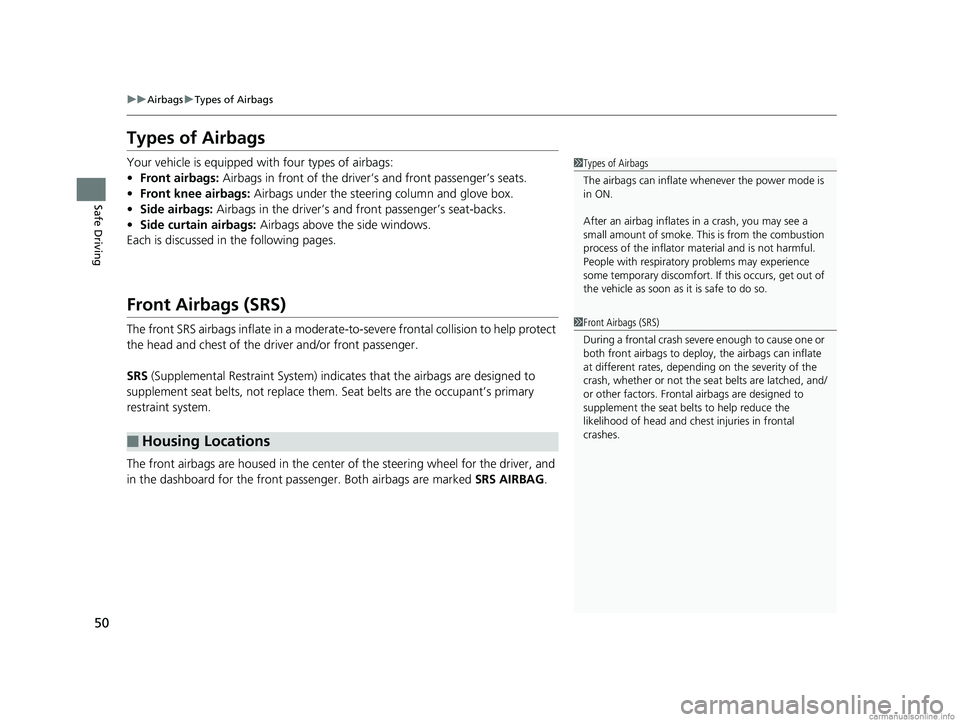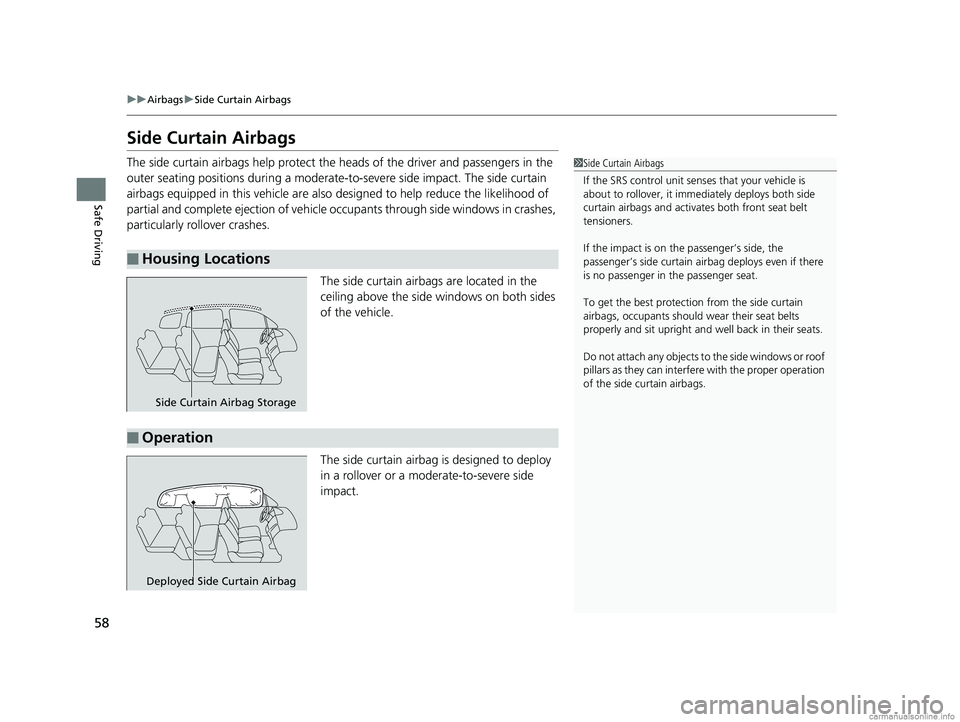2018 HONDA ODYSSEY window
[x] Cancel search: windowPage 4 of 763

Contents
This owner’s manual should be considered a permanent part of the
vehicle and should remain with the vehicle when it is sold.
This owner’s manual covers all models of your vehicle. You may find
descriptions of equipment and features that are not on your
particular model.
Images throughout this owner’s manu al (including the front cover)
represent features and equipment that are available on some, but
not all, models. Your particular mo del may not have some of these
features.
This owner’s manual is for vehicles sold in the United States and
Canada.
The information and specifications in cluded in this publication were
in effect at the time of approval for printing. Honda Motor Co., Ltd.
reserves the right, however, to discontinue or change specifications
or design at any time without notice and without incurring any
obligation.2 Safe Driving P. 33
For Safe Driving P. 34 Seat Belts P. 38 Airbags P. 47
2Instrument Panel P. 83
Indicators P. 84 Gauges and Displays P. 119
2Controls P. 141
Clock P. 142 Locking and Unlocking the Doors P. 144
Security System P. 179 Opening and Closing the Windows P. 182
Adjusting the Mirrors P. 206 Adjusting the Seats P. 209
2Features P. 259
Audio System P. 260 Audio System Basic Operation P. 267, 285
Blu-ray/DVD Rear Entertainment System* P. 396
CabinWatchTM * P. 521 CabinTalkTM* P. 522
2Driving P. 523
Before Driving P. 524 Towing a Trailer P. 530
Multi-View Rear Camera P. 628 Refueling P. 630
2 Maintenance P. 635
Before Performing Maintenance P. 636 Maintenance MinderTM P. 639
Checking and Maintaining Wiper Blades P. 669
Remote Control and Wireless Headphone Care
* P. 685
2 Handling the Unexpected P. 697
Tools P. 698 If a Tire Goes Flat P. 699
Indicator, Coming On/Blinking P. 716 Fuses P. 722
When You Cannot Open the Tailgate P. 731
2 Information P. 737
Specifications P. 738 Identification Numbers P. 740
Warranty Coverages P. 746 Authorized Manuals P. 748
18 US ODYSSEY-31THR6010.book 2 ページ 2018年12月6日 木曜日 午後4時18分
Page 6 of 763

4
Quick Reference Guide
Quick Reference Guide
Visual Index
❙ (Vehicle Stability Assist (VSA®) System OFF) Button (P590)
❙Road Departure Mitigation (RDM) Button* (P578)
❙Power Sliding Door Switch* (P173, 174)
❙Climate Control System (P248)
❙Driving Position Memory System Buttons* (P203)
❙Accessory Power Socket (P233)
❙Power Tailgate Button* (P163)
❙Parking Sensor System Switch* (P620)
❙Collision Mitigation Braking SystemTM (CMBSTM) OFF Button* (P611)
❙Heated Windshield Button* (P202)
❙Electric Parking Brake Switch (P600)
❙Automatic Brake Hold Button (P604)
❙Shift Button
Automatic Transmission
(P544)
❙ECON Button (P557)
❙SNOW Button (P558)
❙Auto Idle Stop OFF Button* (P552)
❙Hazard Warning Button
❙AC Power Outlet* (P235)
❙System Indicators (P84)
❙Gauges (P119)
❙Driver Information Interface (P120)
❙Audio System (P260)
❙Navigation System* () See Navigation System Manual
❙Rear Window Defogger (P201)
❙Heated Mirror Button* (P201)
❙Seat Heater Switches* (P242)
❙Seat Heater and Seat Ventilation
Switches* (P243)
❙Center Pocket* (P230)
❙Blu-ray/DVD Rear Entertainment System* (P396)
18 US ODYSSEY-31THR6010.book 4 ページ 2018年12月6日 木曜日 午後4時18分
Page 8 of 763

Visual Index
6
Quick Reference Guide
❙Door Mirror Controls (P207)
❙Master Door Lock Switch (P156)
❙Hood Release Handle (P646)
❙Power Window Switches (P182)
❙Rearview Mirror (P206)
❙Driver Side Fuse Box (P724)
❙Glove Box (P227)
❙Driver’s Front Airbag (P50)
❙Passenger’s Knee Airbag
(P54)
❙Driver’s Knee Airbag (P54)
❙Auxiliary Input Jack (P262)
❙USB Port (P261)
❙Passenger’s Front Airbag
(P50)
❙HomeLink® Buttons* (P468)
18 US ODYSSEY-31THR6010.book 6 ページ 2018年12月6日 木曜日 午後4時18分
Page 19 of 763

17
Quick Reference Guide
Power Door Mirrors
(P207)
●With the power mode in ON, move the
selector switch to L or R .
● Push the appropriate edge of the
adjustment switch to adjust the mirror.
● Press the folding button
* to fold the door
mirrors in and out.
● Place the selector switch in the L or R
position to use the reverse tilt door mirror
feature.
Selector Switch
Adjustment Switch
Folding
Button*
Models with driving position memory system
Power Windows (P182)
● With the power mode in ON, open and
close the power windows.
● If the power window lock button is in the
off position, each passenger’s window
can be opened and closed with its own
switch.
● If the power window lock button is in the
on position (indicator is on), each
passenger’s window switch is disabled.
Power Window
Lock Button
Window Switch
Indicator
* Not available on all models
18 US ODYSSEY-31THR6010.book 17 ページ 2018年12月6日 木曜日 午後4時18分
Page 30 of 763

28
Quick Reference Guide
Maintenance (P635)
Under the Hood (P645)
● Check engine oil, engine coolant, and window washer fluid. Add
when necessary.
● Check brake fluid.
● Check the battery condition monthly.
aPull the hood release handle under the corner of the dashboard.
bLocate the hood latch lever, pull it up, and then raise the hood.
Once you have raised the hood slightly, you can release the lever.
cWhen finished, close the hood and make sure it is firmly locked in
place.
Lights (P658)
● Inspect all lights regularly.
Wiper Blades (P669)
● Replace blades if they leave
streaks across the windshield.
Tires (P673)
● Inspect tires and wheels
regularly.
● Check tire pressures
regularly.
● Install snow tires for winter
driving.
18 US ODYSSEY-31THR6010.book 28 ページ 2018年12月6日 木曜日 午後4時18分
Page 50 of 763

48
uuAirbags uAirbag System Components
Safe Driving
The front, driver’s and passenger’s knee,
front side, and side curtain airbags are
deployed according to the direction and
severity of impact. Both side curtain airbags
are deployed in a ro llover. The airbag
system includes:
aTwo SRS (Supplemental Restraint System)
front airbags. The driver’s airbag is stored
in the center of the steering wheel; the
front passenger’s airbag is stored in the
dashboard. Both are marked SRS
AIRBAG.
bTwo front knee airbags. The driver’s knee
airbag is stored under the steering
column. The front passenger’s knee
airbag is stored under the glove box.
Both are marked SRS AIRBAG.
cTwo side airbags, one for the driver and
one for a front passenger. The airbags are
stored in the outer edges of the seat-
backs. Both are marked SIDE AIRBAG .
dTwo side curtain airbags, one for each
side of the vehicle. The airbags are stored
in the ceiling, above the side windows. The front and rear pillars are marked
SIDE CURTAIN AIRBAG
.
eAn electronic control unit that, when the
vehicle is on, continually monitors
information about the various impact
sensors, seat and buckle sensors, rollover
sensor, airbag activators, seat belt
tensioners, and other vehicle
information. During a crash event the
unit can record such information.
fAutomatic front seat belt tensioners. In
addition, the driver’s and front
passenger’s seat belt buckles incorporate
sensors that detect whether or not they
are fastened.
gA driver’s seat position sensor. If the seat
is too far forward, the airbag will inflate
with less force.
hWeight sensors in the front passenger’s
seat. The front passenger’s airbag will be
turned off if the weight on the seat is
approximately 65 lbs (29 kg) or less (the
weight of an infant or small child).
iImpact sensors that can detect a
moderate-to-severe front or side impact.
jAn indicator on the dashboard that alerts
you that the front passenger’s front
airbag has been turned off.
kAn indicator on the instrument panel that
alerts you to a possible problem with your
airbag system or seat belt tensioners.
lSafing Sensor
mA rollover sensor that can detect if your
vehicle is about to roll over and signal the
control unit to deploy both side curtain
airbags.
18 US ODYSSEY-31THR6010.book 48 ページ 2018年12月6日 木曜日 午後4時18分
Page 52 of 763

50
uuAirbags uTypes of Airbags
Safe Driving
Types of Airbags
Your vehicle is equipped with four types of airbags:
• Front airbags: Airbags in front of the driver ’s and front passenger’s seats.
• Front knee airbags: Airbags under the steerin g column and glove box.
• Side airbags: Airbags in the driver’s and front passenger’s seat-backs.
• Side curtain airbags: Airbags above the side windows.
Each is discussed in the following pages.
Front Airbags (SRS)
The front SRS airbags inflate in a moderate-to -severe frontal collision to help protect
the head and chest of the driver and/or front passenger.
SRS (Supplemental Restraint System) indicates that the airbags are designed to
supplement seat belts, not replace them. Seat belts are the occupant’s primary
restraint system.
The front airbags are housed in the center of the steering wheel for the driver, and
in the dashboard for the front pass enger. Both airbags are marked SRS AIRBAG.
■Housing Locations
1Types of Airbags
The airbags can inflate whenever the power mode is
in ON.
After an airbag inflates in a crash, you may see a
small amount of smoke. This is from the combustion
process of the infl ator material and is not harmful.
People with respiratory pr oblems may experience
some temporary discomfort. If this occurs, get out of
the vehicle as soon as it is safe to do so.
1 Front Airbags (SRS)
During a frontal crash severe enough to cause one or
both front airbags to deploy, the airbags can inflate
at different rates, dependi ng on the severity of the
crash, whether or not the se at belts are latched, and/
or other factors. Frontal airbags are designed to
supplement the seat belts to help reduce the
likelihood of head and chest injuries in frontal
crashes.
18 US ODYSSEY-31THR6010.book 50 ページ 2018年12月6日 木曜日 午後4時18分
Page 60 of 763

58
uuAirbags uSide Curtain Airbags
Safe Driving
Side Curtain Airbags
The side curtain airbags help protect the heads of the driver and passengers in the
outer seating positions during a moderate-to -severe side impact. The side curtain
airbags equipped in th is vehicle are also designed to help reduce the likelihood of
partial and complete ejection of vehicle occupants through side windows in crashes,
particularly rollover crashes.
The side curtain airbags are located in the
ceiling above the side windows on both sides
of the vehicle.
The side curtain airbag is designed to deploy
in a rollover or a moderate-to-severe side
impact.
■Housing Locations
1Side Curtain Airbags
If the SRS control unit sens es that your vehicle is
about to rollover, it imme diately deploys both side
curtain airbags and activates both front seat belt
tensioners.
If the impact is on the passenger’s side, the
passenger’s side curtain airbag deploys even if there
is no passenger in the passenger seat.
To get the best protecti on from the side curtain
airbags, occupants should wear their seat belts
properly and sit upr ight and well back in their seats.
Do not attach any objects to the side windows or roof
pillars as they can interfere with the proper operation
of the side curtain airbags.
Side Curtain Airbag Storage
■Operation
Deployed Side Curtain Airbag
18 US ODYSSEY-31THR6010.book 58 ページ 2018年12月6日 木曜日 午後4時18分